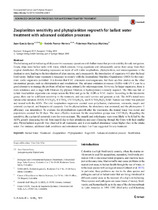Zooplankton sensitivity and phytoplankton regrowth for ballast water treatment with advanced oxidation processes
Fecha
2018Autor
García-Garay, Juan
Franco Herrera, Andrés
Machuca-Martinez, Fiderman
Documentos PDF
Resumen
The ballasting and de-ballasting of ships are two necessary operations with ballast water that provide stability for safe navigation.
Empty ships must ballast tanks with water, which contains living organisms and subsequently carries them away from their
original distribution. De-ballasting represents an input of still viable zooplankton, phytoplankton, and microorganisms in the
destination port, leading to the introduction of alien species, and consequently, the introduction of organisms will alter the local
biodiversity. Ballast water treatment is necessary to comply with the International Maritime Organization (IMO) for the maximum
viable organisms permitted. It is known that UVC eliminates microorganisms, but there are few studies on the other
taxonomical groups, such as phytoplankton and zooplankton. The advance oxidation processes (AOPs) with UV-C can be a
good alternative to manage the problem of ballast water, primarily for microorganisms. However, for larger organisms, there is
more resistance, and, a stage with filtration (by physical filtration or hydrocyclone) is usually required. The filter can fail, or
certain zooplankton organisms can escape across the filter and go to the AOPs or UVC reactor. According to the taxonomic
group, there can be a different sensitivity to the treatment, and one could survive and generate a risk. The AOPs tested were
natural solar radiation (RAD), UV/H2O2, UV/TiO2, UV/TiO2/H2O2, and UV/TiO2/H2O2/RAD. Natural sea water was pumped
and treated with the AOPs. The vital zooplankton organisms counted were polychaetes, cladocerans, ostracods, nauplii and
calanoid, cyclopoid, and harpacticoid copepods. For the phytoplankton, the abundance was estimated, and the photosystem II
efficiency was determined. To evaluate the phytoplankton regrowth after the treatments, the treated water was stored and
populations counted for 20 days. The most effective treatment for the zooplankton groups was UVC/H2O2. Regarding the
sensitivity, the cyclopoid copepods were the most resistant. The nauplii and polychaetes were more likely to be killed by the
AOPs, greatly decreasing the risk from nauplii due to their abundance and ease of passing through the filters with their smaller
size. Phytoplankton regrowth was observed in all treatments, and it even reached abundance values higher than in the intake
water. For instance, additional dark conditions and retreatment on days 3 or 5 are suggested for any treatment.
Palabras clave
Ballast water; Treatment; Zooplankton; Phytoplankton; Regrowth; Advanced oxidation process; SterilizationEnlace al recurso
https://doi.org/10.1007/s11356-018-2308-4Colecciones
Estadísticas Google Analytics
Comentarios
Respuesta Comentario Repositorio Expeditio
Gracias por tomarse el tiempo para darnos su opinión.

